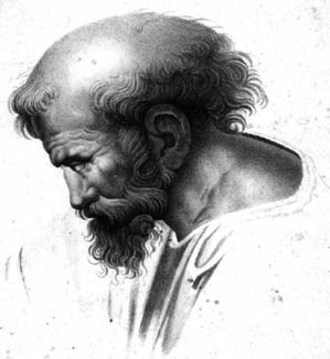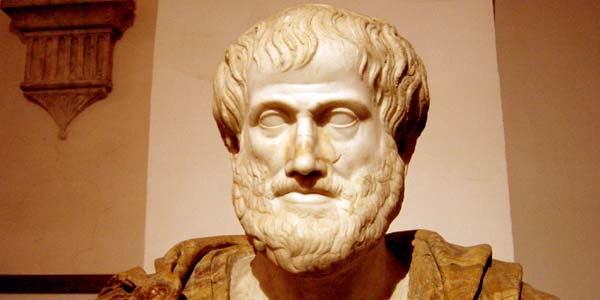Aristotele e il “Principio di non-contraddizione”.
Fu Eraclito, il più grande filosofo dell’antichità, il primo ad argomentare su questo tipo di “principi”. Vissuto mezzo millennio prima di Cristo, pre-socratico, non fu un filosofo di facile comprensione. Estremamente dotto, le sue affermazioni erano comprensibili solo agli eruditi di ogni epoca, la nostra compresa. E non aiutano certo a comprenderne il pensiero i pochi frammenti pervenutici delle sue opere. Certamente Aristotele (vissuto 100 anni dopo ca.) aveva letto le sue opere, le aveva comprese, ma non ne condivideva il pensiero.
Uno dei pensieri più profondi di Eraclito fu quello di vedere nella “contrapposizione” l’essenza stessa dell’ Universo, quindi della “Vita”, quindi dell’ ”Uomo”. Nulla può “essere” senza il suo “opposto”, cioè ogni cosa ha senso solo se c’è il suo opposto: bene e male, pace e guerra, ecc.. Gli esempi sarebbero infiniti, ricordo solo una battuta di Pippo (l’amico di Topolino), che, guardando una salita dall’alto disse: “strano come una salita sembra proprio una discesa”. Eraclito non parlò mai di “Principio di non Contraddizione”, ma la sua “logica” si esplicava nel passaggio da uno stato al suo opposto: l’uomo “diviene” passando ad esempio dallo stato di “essere” a quello di “non-essere”, dalla “vita” alla “morte”, dalla “pace” alla “guerra”, ecc..
Fu Aristotele, che ben aveva compreso la “logica degli opposti” di Eraclito, a porre le basi per la “logica moderna”, basata essenzialmente sul “Principio di non-contraddizione”: se una cosa “è” non può contemporaneamente “non-essere”, se un colore è bianco non può essere al tempo stesso nero, e così via.
Aristotele, si sa, è il filosofo dell’ “immanente”, al contrario di Platone che fu il filosofo del “trascendente”. Al Principio di non contraddizione aristotelico si è informata tutta la scienza antica e moderna. Tale concetto è applicato alla “scienza” nel suo complesso, ma intesa soprattutto come “conoscenza” dei fatti che governano il mondo e l’Universo.
E ciò che separa la “scienza” dalla “fede”, vale a dire il confine tra le due aree, è da ritrovarsi proprio nella applicabilità del “Principio di non contraddizione”: esso è applicabile alle leggi terrene e non a quelle divine. In altre parole questo principio è il caposaldo della scienza, mentre per il divino vale ancora il principio eracliteo della “logica degli opposti”: Dio è divino ed è umano, Dio è uno e trino, la Madonna è vergine ed ha partorito, Dio perdona e punisce, e così via.
La linea di confine tra terreno e divino è una linea “netta”, “precisa”. O si è per la logica aristotelica oppure si è per quella eraclitea. Entrambi i mondi esistono, e se il mondo terreno si espande man mano che cresce la conoscenza, non si può dire che esso cresca a discapito del mondo divino, perché quest’ultimo inizia là dove finisce l’altro sì, ma si estende sempre all’infinito.
E’ questa la posizione dell’ “agnosticismo”, ed io sono “agnostico”.
Il problema che si pone (a me stesso intendo) oggi è il seguente: la linea “netta e precisa” che rappresenta il confine tra terreno e divino è ancora tale oggi, alla luce delle nuove scoperte scientifiche? La scienza cioè può essere il veicolo attraverso il quale il divino diventa più vicino al terreno, più comprensibile e quindi meno “alieno”? L’ “ateismo” ha ancora ragion d’essere?
Il principio di non contraddizione si basa essenzialmente sul concetto che una affermazione non può essere contemporaneamente vera e falsa. Né ci si può appellare alle cosiddette “condizioni al contorno” (espressione in uso in matematica) ovvero al “contesto”. I politici, quando i media li accusano di aver detto qualcosa di non condivisibile se non falsa, sono soliti dire che la loro affermazione è stata fraintesa e che in realtà nel contesto in cui fu detta aveva ben altro significato. Lasciamo ai politici e ai mentitori i giochi di parola. Cosa detta è detta. Punto.
Già. Ma c’è un “già”!!!
La “geometria euclidea” l’ha fatta da padrona per 2000 anni. Poi qualcuno l’ha demolita ed ora è solo una fattispecie, non è il “verbo”, non corrisponde alla “realtà” se non in misura minima ed insignificante. Ne ho già parlato in un altro post. Lo stesso Einstein tentava di unificare in un unico “campo” sia quello “gravitazionale” che quello “elettromagnetico”. La sua intuizione ci da oggi la misura della sua genialità.
Il “Principio di non contraddizione” è meno importante di prima. Ad esso si affianca il “Principio della complementarità” , mediante il quale si esprime il concetto che le particelle elementari dell’universo, l’elettrone (oggetto fisico, solido, “tangibile”, “materia”) e il fotone (oggetto non fisico, non solido, “non tangibile”, “immateriale perché è luce”), mostrano entrambe la duplice natura: corpuscolare ed ondulatoria. In altre parole sono la stessa cosa.
Alla luce di questi fatti sembra proprio che il principio aristotelico vada in pensione, insieme alla linea “netta e precisa” che divide il terreno dal divino. Verrebbe quindi a mancare, come si dice in matematica, quella zona di “singolarità” tra le due aree, per la quale non si potrebbe passare dall’una all’altra. Tra le due aree non c’è invece “soluzione di continuità”. Si passa in maniera graduale dal terreno al divino. L’ateismo non ha senso, mentre ne ha ancora l’ “agnosticismo”. E questa è ancora una conquista della scienza.
Aristotle and the “Principle of non-contradiction.”
Heraclitus, the greatest philosopher of antiquity, has been the first to speak about this kind of principles. Lived half a millennium before Christ, the pre-Socratic philosopher was not easy to understand. Very learned, his statements were understandable only to scholars of all ages, including ours. And the few surviving fragments of his works do not help us to understand his thinking. Certainly Aristotle (who lived approx. 100 years after) had read and understood his works, but did not share the thought.
One of the deepest thoughts of Heraclitus was to see in the “opposition” the essence of the ‘Universe, of the “Life” and of the “Man”. Nothing can “be” without its “opposite”, that is everything makes sense only if there is its opposite: good and evil, war and peace, etc. .. Examples would be endless, I only remember a joke of Goofy (Mickey Mouse’s friend), who, looking down from a descent said: “funny how a climb looks like a descent.” Heraclitus never spoke of “Principle of non-contradiction,” but his “logic” is expressed in the transition from one state to its opposite: the man “becomes” for example moving from the state of “being” to that of “not- being” from “life “to” death “, from “peace “to” war “, and so on.
It was Aristotle, who well understood the “logic of opposites” of Heraclitus, to lay the groundwork for the “modern logic”, essentially based on the “Principle of non-contradiction”: if something “is” it cannot simultaneously be “is not”, if a color is white it cannot be at the same time black, and so on.
Aristotle, as everyone knows, is the philosopher of the “immanent”, as opposed to Plato, who was the philosopher of the “transcendent.” The “Principle of non-contradiction” has been the guiding principle of all ancient and modern science. This concept is applied to the “science” as a whole, mainly as “knowledge” of the facts that govern the world and the Universe.
And what separates the “science” from “faith”, i.e. the boundary between the two areas, is to be found precisely in the application of the “principle of non-contradiction”: it is applicable to earthly laws and not to the divine. In other words, The science obeys to this principle, while the divine still obeys to the Heraclitean principle of the “logic of opposites”: God is divine and human, God is one and three, the Virgin Mary is a virgin and gave birth, God forgives and punishes, and so on.
The boundary between the science and the religion is a “net” and “precise” line. You can trust in the aristotelian logic or in the heraclitean one, but both worlds exist, and, if the knowledge expands his border, we cannot say that this appens at the expense of the divine world, because the latter begins where the other ends but always extend to “infinite”.
And this is the position of “agnosticis”. And I am “agnostic”.
The problem that arises (to myself I mean) today is as follows: the line “clear and precise” that represents the boundary between the science and the religion is still that today, in the light of new scientific discoveries? The science, I mean, may be the vehicle through which the religion becomes closer to the science and, in that way, closer to us, more understandable and therefore less “alien”?
“Atheism” has yet “raison d’etre” ?
The principle of non-contradiction is essentially based on the concept that a statement can not be both true and false. Neither one can appeal to so-called “boundary conditions” (a term used in mathematics) or the “context”. Politicians, when the media accuse them of saying something which cannot be shared, they usually say that their claim has been misunderstood and that in fact in the context in which it was said had a very different meaning. Leave to politicians and liars the word games. Everything said is said. Full stop.
But there is a doubt!
The “Euclidean geometry” was considered the only possible geometry for 2000 years. Then someone has torn down and is now just a case, is not the “word”, does not match the “reality” but only slightly and insignificant. I’ve written about in another post. Einstein himself tried to unify into a single “field” the “gravitational field” and the “electromagnetic field”. His intuition gives us today the measure of his genius.
The “principle of non-contradiction” is now less important than before. Now what is going up is the “principle of complementarity”, by which is expressed the idea that the building blocks of the universe, the electron (physical object, solid, “tangible” “matter”) and the photon (not a physical object, not solid, “not-tangible”, “immaterial because it is light”), both show the dual nature: corpuscular and wave. In other words they are the same thing.
In the light of these facts it seems that for the Aristotelian principle is time to retire, along with the line “clear and precise” that divides the science from the religion. Would then fail, as they say in mathematics, the area of ”singularity” between the two areas, for which you could not switch between them. Between the two areas there is instead no “solution of continuity”. You can gradually pass from the science to the religion.
Atheism does not make any more sense.
You can be “agnostic”. And this is still a scientific breakthrough.




Devi effettuare l'accesso per postare un commento.